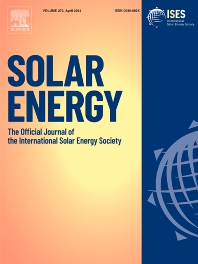Journals in Solar energy
Journals in Solar energy
- ISSN: 0927-0248
Solar Energy Materials and Solar Cells
An International Journal Devoted to Photovoltaic, Photothermal, and Photochemical Solar Energy ConversionSolar Energy Materials & Solar Cells is intended as a vehicle for the dissemination of research results on materials science and technology related to photovoltaic, photothermal and photoelectrochemical solar energy conversion. Materials science is taken in the broadest possible sense and encompasses physics, chemistry, optics, materials fabrication and analysis for all types of materials.Of particular interest are: Solar Cells, covering single crystal, polycrystalline and amorphous materials utilising homojunctions and heterojunctions, Schottky barriers, liquid junctions and their applications. Also of interest is analysis of component materials, individual cells and complete systems, including their economic aspects. Photothermal Devices, in the broadest sense, including solar absorber devices, heat storage materials, radiative cooling systems and their applications. Photoelectrochemical and Photochemical Devices, covering photoelectrodes, photocatalysis, photoconversion and solar desalination systems and their applications. Optical Properties of materials, including light trapping, texturising, solar concentrators which include imaging and non-imaging optical collectors. Light Control, including systems for energy efficient architecture and daylighting, chromogenics and smart windows.The pertinent issues are comprehensive and encompass bulk materials, coatings and thin films and surface treatments, from basic as well as from applications-oriente... and manufacturing related perspectives.Manuscr... of general interest not being suitable for Solar Energy Materials and Solar Cells can be submitted to Refocus, which publishes magazine-style feature articles concerning all aspects of renewable energy. Please e-mail David Hopwood, Editor for further details (d.hopwood@elsevier.... and visit http://www.re-focus.... articles not specifically related to the materials aspects of Solar Energy conversion can be submitted to Solar Energy, the official journal of the International Solar Energy Society. For details, visit https://www.elsevier... journal welcomes contributions that support and advance the UN's sustainable development goals, in particular SDG 7 (Affordable and clean energy)
- ISSN: 0038-092X
Solar Energy
The Official Journal of the International Solar Energy Society®Solar Energy, the official journal of the International Solar Energy Society®, is devoted exclusively to the science and technology of solar energy applications.ISES is an UN-accredited membership-based NGO founded in 1954. For over 60 years, ISES members from more than 100 countries have undertaken the product research and development that has helped the renewable energy industry to grow. ISES serves as a center for information on research and development in solar energy through its publications and key activities such as annual technical conferences, a free webinar series and dedicated student programmes. The ISES vision statement is: 100% renewable energy for everyone used wisely and efficiently. Solar Energy welcomes manuscripts presenting information not previously published in journals on any aspect of solar energy research, development, application, measurement or policy. The term "solar energy" in this context includes the indirect uses such as wind energy and biomass. Because of the international character of Solar Energy, articles that deal solely with the solar radiation or wind data base of a specific country are not normally considered suitable for Solar Energy. Submitted manuscripts may take the form of reports of original studies or reviews of significant prior work in a given area. All manuscripts are subject to reviews to assure accuracy, clarity, and long-term value.This journal welcomes contributions that support and advance the UN's sustainable development goals, in particular SDG 7 (Affordable and clean energy) and SDG 13 (Climate Action)